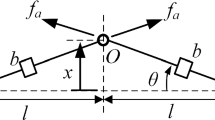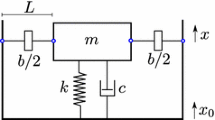Abstract
This study presents an inerter-based nonlinear vibration isolator with geometrical nonlinearity created by configuring an inerter in a diamond-shaped linkage mechanism. The isolation performance of the proposed nonlinear isolator subjected to force or base-motion excitations is investigated. Both analytical and alternating frequency-time harmonic balance methods as well as numerical integration method are used to obtain the dynamic response. Beneficial performance of the nonlinear isolator is demonstrated by various performance indices including the force and displacement transmissibility as well as power flow variables. It is found that the use of the nonlinear inerter in the isolator can shift and bend the peaks of the transmissibility and time-averaged power flow to the low-frequency range, creating a larger frequency band of effective vibration isolation. It is also shown that the inertance-to-mass ratio and the initial distance of the nonlinear inerter can be effectively tailored to achieve reduced transmissibility and power transmission at interested frequencies. Anti-resonant peaks appear at specific frequency, creating near-zero energy transmission and significantly reducing vibration transmission to a base structure on which the proposed isolator is mounted.
















Similar content being viewed by others
Data availability
The datasets generated during and/or analysed during the current study are available from the corresponding author on reasonable request.
References
Smith, M.C.: Synthesis of mechanical networks: the inerter. IEEE Trans. Autom. Control. 47, 1648–1662 (2002)
Arakaki, T., Kuroda, H., Arima, F., Inoue, Y., Baba, K.: Development of seismic devices applied to ball screw: part 1 basic performance test of RD-series. AIJ J. Technol. Des. 5(8), 239–244 (1999)
Arakaki, T., Kuroda, H., Arima, F., Inoue, Y., Baba, K.: Development of seismic devices applied to ball screw: part 2 performance test and evaluation of RD-series. AIJ J. Technol. Des. 5(9), 255–270 (1999)
Chen, M.Z.Q., Papageorgiou, C., Scheibe, F., Wang, F.-C., Smith, M.C.: The missing mechanical circuit element. IEEE Circuits Syst. Mag. 9(1), 10–26 (2009)
Kawamata, S.: Liquid type mass damper with elongated discharge tube. US Patent. 4, 872, 649. https://patents.google.com/patent/US4872649A/en (1989). Accessed 25 Mar 2022
Kawamata, S., Funaki N., Itoh, Y.: Passive control of building frames by means of liquid dampers sealed by viscoelastic material. In: 12th World Conference on Earthquake Engineering, Auckland, New Zealand. (2000)
Swift, S.J., Smith, M.C., Glover, A.R., Papageorgiou, C., Gartner, B., Houghton, N.E.: Design and modelling of a fluid inerter. Int. J. Control 86(11), 2035–2051 (2013)
Wang, F.-C., Hsieh, M.-R., Chen, H.-J.: Stability and performance analysis of a full-train system with inerters. Veh. Syst. Dyn. 50(4), 545–571 (2012)
Lazar, I.F., Neild, S.A., Wagg, D.J.: Vibration suppression of cables using tuned inerter dampers. Eng. Struct. 122(1), 62–71 (2016)
Li, Y., Jiang, J.Z., Neild, S.A.: Inerter-based configurations for main-landing-gear shimmy suppression. J. Aircr. 54(2), 684–693 (2017)
Zhang, S.Y., Jiang, J.Z., Neild, S.A.: Optimal configurations for a linear vibration suppression device in a multi-storey building. Struct. Control Health Monit. 24, 1887 (2017)
Li, Y.-Y., Zhang, S.Y., Jiang, J.Z., Neild, S.: Identification of beneficial mass-included inerter-based vibration suppression configurations. J Franklin Inst. 356, 7836–7854 (2019)
Zhu, C., Yang, J., Rudd, C.: Vibration transmission and power flow of laminated composite plates with inerter-based suppression configurations. Int. J. Mech. Sci. 190, 106012 (2021)
Dong, Z., Chronopoulos, D., Yang, J.: Enhancement of wave damping for metamaterial beam structures with embedded inerter-based configurations. Appl. Acoust. 178, 108013 (2021)
Liu, Y., Yang, J., Yi, X., Chronopoulos, D.: Enhanced suppression of low-frequency vibration transmission in metamaterials with linear and nonlinear inerters. J. Appl. Phys. 131, 105103 (2022)
Shi, B., Yang, J., Jiang, J.Z.: Tuning methods for tuned inerter dampers coupled to nonlinear primary systems. Nonlinear Dyn. 107, 1663–1685 (2022)
Moraes, F.D.H., Silveira, M., Gonçalves, P.J.P.: On the dynamics of a vibration isolator with geometrically nonlinear inerter. Nonlinear Dyn. 93(3), 1325–1340 (2018)
Yang, J., Jiang, J.Z., Neild, S.A.: Dynamic analysis and performance evaluation of nonlinear inerter-based vibration isolators. Nonlinear Dyn. 99, 1823–1839 (2020)
Wang, Y., Wang, R., Meng, H., Zhang, B.: An investigation of the dynamic performance of lateral inerter-based vibration isolator with geometrical nonlinearity. Arch. Appl. Mech. 89, 1953–1972 (2019)
Dong, Z., Shi, B., Yang, J., Li, T.Y.: Suppression of vibration transmission in coupled systems with an inerter-based nonlinear joint. Nonlinear Dyn. 107, 1637–1662 (2022)
Zhang, Z., Lu, Z.-Q., Ding, H., Chen, L.-Q.: An inertial nonlinear energy sink. J. Sound Vib. 450, 192–213 (2019)
Wagg, D.J.: A review of the mechanical inerter: historical context, physical realisations and nonlinear applications. Nonlinear Dyn. 104, 13–34 (2021)
Ibrahim, R.A.: Recent advances in nonlinear passive vibration isolators. J. Sound Vib. 314(3–5), 371–452 (2008)
Kovacic, I., Brennan, M.J., Waters, T.P.: A study of a nonlinear vibration isolator with a quasi zero stiffness characteristic. J. Sound Vib. 315(3), 700–711 (2008)
Carrella, A., Brennan, M.J., Waters, T.P., Lopes, V.: Force and displacement transmissibility of a nonlinear isolator with high-static-low-dynamic-stiffness. Int. J. Mech. Sci. 55, 22–29 (2012)
Goyder, H.G.D., White, R.G.: Vibrational power flow from machines into built-up structures. J. Sound Vib. 68, 59–117 (1980)
Royston, T.J., Singh, R.: Optimization of passive and active non-linear vibration mounting systems based on vibratory power transmission. J. Sound Vib. 194, 295–316 (1996)
Xiong, Y.P., Xing, J.T., Price, W.G.: Interactive power flow characteristics of an integrated equipment-nonlinear isolator-travelling flexible ship excited by sea waves. J. Sound Vib. 287, 245–276 (2005)
Yang, J., Xiong, Y.P., Xing, J.T.: Nonlinear power flow analysis of the Duffing oscillator. Mech. Syst. Signal Process. 45, 563–578 (2014)
Yang, J., Xiong, Y.P., Xing, J.T.: Vibration power flow and force transmission behaviour of a nonlinear isolator mounted on a nonlinear base. Int. J. Mech. Sci. 115–116, 238–252 (2016)
Shi, B., Yang, J., Rudd, C.: On vibration transmission in oscillating systems incorporating bilinear stiffness and damping elements. Int. J. Mech. Sci. 150, 458–470 (2019)
Dai, W., Yang, J., Shi, B.: Vibration transmission and power flow in impact oscillators with linear and nonlinear constraints. Int. J. Mech. Sci. 168, 105234 (2020)
Von Groll, G., Ewins, D.J.: The harmonic balance method with arc-length continuation in rotor/stator contact problems. J. Sound Vib. 241, 223–233 (2001)
Nayfeh, A.H., Balachandran, B.: Applied Nonlinear Dynamics: Analytical, Computational, and Experimental Methods. Wiley, New Jersey (2008)
Cammarano, A., Hill, T.L., Neild, S.A., Wagg, D.J.: Bifurcations of backbone curves for systems of coupled nonlinear two mass oscillator. Nonlinear Dyn. 77, 311–320 (2014)
Acknowledgements
This work was supported by the National Natural Science Foundation of China under grant number 12172185 and by the Zhejiang Provincial Natural Science Foundation of China under Grant Number LY22A020006.
Funding
Jian Yang was funded by the National Natural Science Foundation of China under Grant Number 12172185 and by the Zhejiang Provincial Natural Science Foundation of China under Grant Number LY22A020006.
Author information
Authors and Affiliations
Corresponding author
Ethics declarations
Conflict of interest
We have no conflicts of interest to declare.
Additional information
Publisher's Note
Springer Nature remains neutral with regard to jurisdictional claims in published maps and institutional affiliations.
Appendix
Appendix
Using Eqs. (28), (29) and (43), governing Eq. (14) of the single-DOF oscillator with base-motion excitation (C2 configuration) becomes
The coefficients of the corresponding harmonic terms in Eq. (61) can be balanced, leading to
By using the identity of \(\cos^{2} \phi + \sin^{2} \phi = 1\), Eqs. (62) and (63) can be transformed into
Note that Eq. (65) is obtained by rewriting Eq. (64), which can be solved by using a bisection method to obtain the amplitude \(R_{2}\) of the relative displacement. The phase angle \(\theta\) can then be determined by using Eqs. (62) and (63). When the excitation frequency \(\Omega\) approaching infinity, Eq. (65) becomes
in which, by denoting the corresponding value of \(R_{2}\) as \(R_{2,\infty }\), we have
which is a nonlinear algebraic equation which can be solved by a standard bisection method. It shows that the relative displacement amplitude \(R_{2,\infty }\) is only related to the design parameters of \(\lambda , D_{0}\) and \(Q_{0}\) of the isolator.
It is noted that the nondimensional displacement response \(X_{2} \left( \tau \right)\) of the mass in C2 is expressed by
Therefore, the displacement amplitude \(M_{2}\) of the mass in C2 can be obtained as
where Eq. (62) is used for the simplification.
Rights and permissions
About this article
Cite this article
Shi, B., Dai, W. & Yang, J. Performance analysis of a nonlinear inerter-based vibration isolator with inerter embedded in a linkage mechanism. Nonlinear Dyn 109, 419–442 (2022). https://doi.org/10.1007/s11071-022-07564-7
Received:
Accepted:
Published:
Issue Date:
DOI: https://doi.org/10.1007/s11071-022-07564-7




